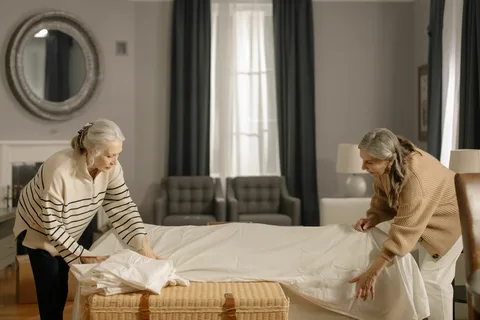Introduction: The Unique Challenges of Senior Moves
Moving later in life is often more complex than a typical relocation. Seniors face unique emotional and physical challenges, especially when it comes to downsizing decades of belongings. For families and individuals, hiring a professional Flyttfirma Helsingborg can make the process far easier, but preparation and thoughtful planning are equally important.
This guide will help seniors — and their loved ones — approach downsizing with clarity, compassion, and confidence, turning what could be overwhelming into a smooth and stress-free transition.
The Problem: Why Senior Downsizing Feels Overwhelming
Downsizing can be difficult because it combines three layers of challenges:
- Physical Demands: Lifting, packing, and organizing can be exhausting.
- Emotional Attachments: Many belongings hold memories, making it hard to let go.
- Practical Decisions: Choosing what to keep, donate, or discard requires time and energy.
These challenges can feel even more daunting when seniors are moving to smaller homes, retirement communities, or assisted living facilities. Without a clear plan, the process may become stressful for both seniors and family members.
The Solution: Plan, Simplify, and Seek Professional Support
To ease these challenges, it’s essential to create a plan that balances emotional care with practical efficiency. Enlisting licensed and insured movers ensures belongings are handled safely, while breaking the process into small, manageable steps helps reduce stress.
Step 1: Start with a Clear Timeline
Why Timing Matters
Unlike last-minute relocations, senior moves require thoughtful pacing. Begin planning at least 8–12 weeks before the move date. This allows time to:
- Sort through items gradually.
- Schedule donation pickups or estate sales.
- Coordinate family involvement.
- Book movers at the best rates.
How to Create a Timeline
- Week 1–2: Identify essentials and sentimental items.
- Week 3–6: Declutter each room, one at a time.
- Week 7–8: Pack non-essentials and prepare donations.
- Final Weeks: Pack daily essentials and confirm moving arrangements.
Step 2: Downsizing Made Simple
The “Four-Box Method”
Use four boxes labeled: Keep, Donate, Sell, Discard. This system helps make decisions easier and reduces clutter.
Prioritize Essentials
Ask questions like:
- Does this item serve a practical purpose?
- Is it truly sentimental or just familiar?
- Will it fit comfortably in the new space?
Digitize Memories
For photos, letters, and documents, consider scanning and storing them digitally. This saves space while preserving memories.
Step 3: Involve Family in the Process
Family involvement can provide emotional support and practical help. Invite children or grandchildren to:
- Claim sentimental items.
- Assist with packing or labeling.
- Help sort through belongings with patience and respect.
This also creates opportunities to share family stories while making the process collaborative instead of isolating.
Step 4: Make the New Space Feel Like Home
Personalize the Layout
Bring familiar furniture, photos, and decorations to the new residence to create a sense of comfort.
Safety Considerations
- Remove tripping hazards (like rugs).
- Place essential items at accessible heights.
- Ensure lighting is adequate for safe mobility.
Comfort First
Consider bringing cozy essentials like a favorite chair, bedding, or keepsakes to ease the emotional adjustment.
Step 5: Work with Professional Moving Services
Hiring movers is especially important for senior relocations. Professionals offer:
- Packing and unpacking help to reduce stress.
- Furniture disassembly/reassembly to prevent strain or injury.
- Specialty moving services for antiques, pianos, or fragile items.
- Storage solutions if downsizing requires extra time to sort.
Movers not only handle the heavy lifting but also provide peace of mind that everything will arrive safely.
Hidden Costs of DIY Senior Moves
Many families think they’ll save money by handling the move themselves. However, DIY moves often cost more when you factor in:
- Truck rental fees and mileage charges.
- Equipment rentals (dollies, straps, blankets).
- Risk of damage to valuable or sentimental items.
- Medical risks of lifting heavy boxes or furniture.
- Extended time and stress for seniors and family members.
Hiring professionals is not just about convenience — it often saves money and prevents unnecessary risks.
Tips for a Stress-Free Downsizing Experience
1. Declutter Early
Don’t wait until the last minute. Decluttering a few items each day is less overwhelming than tackling everything at once.
2. Focus on One Room at a Time
Concentrating on one space prevents the process from feeling chaotic and keeps progress visible.
3. Create a “Memory Box”
Keep a small box of cherished items (letters, photos, keepsakes) to provide emotional comfort during and after the move.
4. Use Color-Coded Labels
Color-coded stickers or labels make unpacking and placement in the new home much easier.
5. Plan for Moving Day Essentials
Prepare a small bag with medications, toiletries, important documents, snacks, and a change of clothes for easy access.
Emotional Support During Senior Moves
Acknowledge the Feelings
It’s normal to feel sadness, anxiety, or reluctance when leaving a longtime home. Give space to express these emotions.
Celebrate the Transition
Focus on the positives: less maintenance, a safer living environment, or being closer to loved ones.
Seek Help if Needed
Counselors, clergy, or senior transition specialists can provide additional support for those struggling emotionally.
Checklist for Families Assisting Seniors
- Start early and create a moving plan.
- Involve seniors in decision-making.
- Arrange donations and pickups in advance.
- Book movers who specialize in senior relocations.
- Prepare the new home for comfort and safety.
Conclusion: Making Downsizing Easier for Seniors
Senior moves don’t have to be stressful or overwhelming. By planning ahead, decluttering with compassion, and working with professional movers, seniors and their families can experience a smoother, safer, and more positive transition.
Downsizing is not just about moving fewer belongings — it’s about creating space for new beginnings. With the right approach, seniors can enter their next chapter feeling supported, comfortable, and stress-free.


